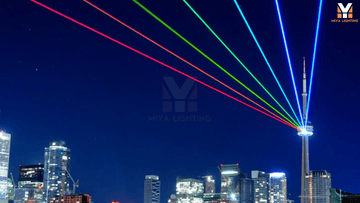
In the rapidly evolving world of technology, laser light has emerged as a powerful tool that is revolutionizing various industries, including landscape transformation. MIYA, a leading laser light supplier, has been at the forefront of this innovation, providing cutting-edge laser solutions that are reshaping how we perceive and interact with natural and urban environments. From precise land surveys to artistic light displays, laser technology is playing a pivotal role in transforming landscapes in ways that were once unimaginable.
The Science Behind Laser Light
Laser light, an acronym for "Light Amplification by Stimulated Emission of Radiation," is a highly focused beam of light with unique properties. Unlike ordinary light, which scatters in multiple directions, laser light is coherent, monochromatic, and can travel long distances without significant dispersion. These characteristics make it an ideal tool for applications requiring precision and accuracy.

MIYA specializes in developing high-quality laser systems that cater to diverse industries. Their lasers are designed to emit beams with pinpoint accuracy, enabling users to perform tasks such as mapping terrains, cutting materials, and creating stunning visual effects. But how exactly does laser light transform landscapes? Let’s delve deeper into its applications.
Applications of Laser Light in Landscape Transformation
1. Land Surveying and Topography
One of the most significant applications of laser light in landscape transformation is land surveying. Traditional surveying methods often involve labor-intensive processes that are time-consuming and prone to human error. However, with MIYA's advanced laser systems, surveyors can now map large areas of land with unparalleled accuracy and speed.
Laser-based tools such as LiDAR (Light Detection and Ranging) use laser pulses to measure distances to the Earth's surface. These measurements are then used to create detailed 3D models of terrains, which are invaluable for urban planning, agriculture, and environmental conservation. MIYA's LiDAR systems are equipped with state-of-the-art technology that ensures high-resolution data capture, even in challenging environments.
2. Architectural and Urban Design
In the realm of architecture and urban design, laser light is enabling professionals to visualize and execute complex projects with precision. MIYA's laser projection systems are widely used for creating virtual blueprints directly on construction sites, eliminating the need for physical markers and reducing the margin of error.
Moreover, laser scanning technology allows architects to assess existing structures and integrate them seamlessly into new designs. This is particularly useful in historic preservation projects, where maintaining the integrity of original structures is crucial. MIYA's lasers provide the accuracy required for such delicate tasks, ensuring that every detail is captured and preserved.
3. Environmental Conservation
Environmental conservation efforts have also benefited greatly from laser technology. MIYA's laser systems are used to monitor changes in landscapes caused by natural phenomena such as erosion, deforestation, and glacial melting. By providing accurate data on these changes, lasers enable scientists and policymakers to make informed decisions for sustainable development.
For example, laser-based remote sensing can track the health of forests and detect illegal logging activities. This data is crucial for implementing conservation strategies and protecting biodiversity. MIYA's commitment to environmental sustainability has led to the development of eco-friendly laser solutions that minimize energy consumption while delivering high performance.
4. Artistic and Recreational Applications
Beyond practical applications, laser light has found a place in the world of art and recreation. MIYA's laser projection systems are widely used for creating mesmerizing light shows that transform landscapes into dynamic canvases of color and motion. These displays are often featured in public parks, festivals, and special events, captivating audiences and enhancing the aesthetic appeal of outdoor spaces.
Additionally, laser light is used in landscaping to create unique visual effects that highlight natural features such as waterfalls, trees, and rock formations. MIYA's innovative laser solutions allow designers to experiment with light and shadow, adding a new dimension to outdoor spaces and creating unforgettable experiences for visitors.
Advantages of Using Laser Technology
The widespread adoption of laser technology in landscape transformation is driven by its numerous advantages. Here are some of the key benefits:
- Precision: Laser systems provide unmatched accuracy, making them ideal for tasks that require meticulous attention to detail.
- Efficiency: Laser-based tools significantly reduce the time and effort required for surveying, mapping, and construction.
- Versatility: From scientific research to artistic endeavors, laser light can be adapted for a wide range of applications.
- Sustainability: MIYA's eco-friendly laser solutions are designed to minimize environmental impact while delivering high performance.
- Innovation: The use of laser technology opens up new possibilities for creativity and problem-solving in landscape transformation.
Challenges and Future Prospects
Despite its many advantages, the use of laser technology in landscape transformation is not without challenges. High initial costs and the need for specialized training can be barriers to adoption for some organizations. Additionally, the integration of laser systems with existing technologies requires careful planning and execution.
However, the future of laser technology in landscape transformation looks promising. Advances in artificial intelligence and machine learning are expected to enhance the capabilities of laser systems, making them more accessible and efficient. MIYA is actively investing in research and development to stay ahead of these trends and continue delivering innovative solutions to its clients.
Conclusion
Laser light is undeniably transforming landscapes in profound ways, from enabling precise land surveys to creating breathtaking visual displays. As a leading laser light supplier, MIYA is playing a crucial role in driving this transformation by providing state-of-the-art laser systems that cater to a wide range of applications.
Whether it's revolutionizing urban planning, supporting environmental conservation, or inspiring artistic expression, laser technology is reshaping our world one beam at a time. With continued advancements and a commitment to sustainability, the possibilities for laser light in landscape transformation are virtually limitless.
As we look to the future, companies like MIYA will undoubtedly remain at the forefront of this exciting field, pushing the boundaries of what laser technology can achieve and helping us reimagine the landscapes of tomorrow.
